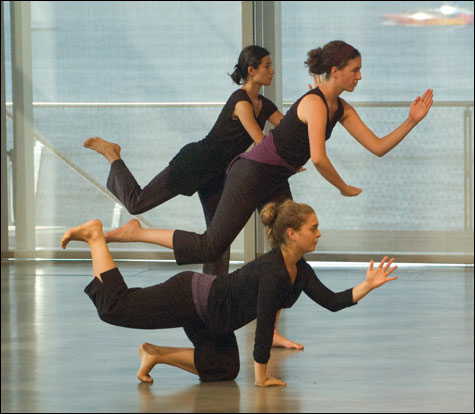
WORK IN PROGRESS: Nothing in these “Dancing-on-View” performances looked like any known
dance technique, but it all looked like dancing. |
Sara Rudner has been making “Dancing-on-View” since 1975. Last week, she brought this extraordinary work to Concord Academy Summer Stages Dance and the Institute for Contemporary Art. “Dancing-on-View” is neither a set piece of choreography nor an improvised free-for-all. You could call it a series of gambits and structures, an evolving research into how bodies can be maximally expressive and minimally stressed, a generator of lifetime dancing pleasure.
For four showings in the Concord Academy dance studio and two long afternoons at the ICA, Rudner assembled nine New York colleagues and eight Boston dancers. They’d been working here together for the past three weeks to produce 35 phrases or chapters of movement. One imagines the segments could be performed in random sequence, collage fashion, but on Wednesday night at Concord and Saturday at the ICA they were done in the same order, and the event took us through build-ups and cooldowns, surprises, reprises, and conclusions, as in a conventional dance piece. Except for the informality.
“Dancing-on-View” imposes a curious duality. We look at super dancers performing with tremendous accomplishment, and at the same time we see them at ground level, as explorers committed to the idea that there’s always more to be learned about themselves and their collective enterprise. Everything has an air of being in progress. To achieve perfect ensemble coordination, they stop and rehearse tiny chunks over and over. They show us refined beginnings and endings, but the endings are provisional, the beginnings continuations. Dancers replace other dancers, learn one another’s roles. The piece will go on into the next decade or the next century.
The audience is thoughtfully provided with a “menu” of items. One dancer sits at the side with a stopwatch to announce the title of each new segment and give the names of featured dancers, so we can learn who they are. Emily Beattie, Kellie Edwards. Carey Foster, Sunny Hitt, Amelia Mitter-Burke, Catherine Murcek, Marissa Palley, and Megan Schenk made up the Boston contingent. The New Yorkers were Megan Boyd, Ashley Byler, Erin Crawley-Woods, Peggy Gould, Anneke Hansen, Rachel Lehrer, Lynne Schlesinger-Ruedeman, Maggie Thom, and Lori Yuill. Plus the incomparable Rudner.
Peggy Gould offered introductory remarks about how Rudner works and what we could expect from the performance. “This is what we do. We work on this material. The audience is free to come and go.” In Concord, most of the viewers had left after an hour and a half. The dancers had gotten through the 14th variation. Rudner announced that this was the end of the performance but that the dancers would keep going and the 9 o’clock audience would take our place.
For the first part of the piece, the dancers are spaced out on the floor. There’s a basic series of moves they all do, with changes called out by one dancer (“GO”), and against this trios, duets, solos emerge to create other phrases or make counterpoint patterns. The floor moves are intricate rearrangements of body parts, folding, spiraling, lengthening — transitions into shapes that look restful even though the dancer’s final position is a twisted, upside-down balance, or her limbs are tangled or oddly rotated. These moves and stops, and variations of them, form a kind of ground bass that returns as a background to other actions throughout the dance.